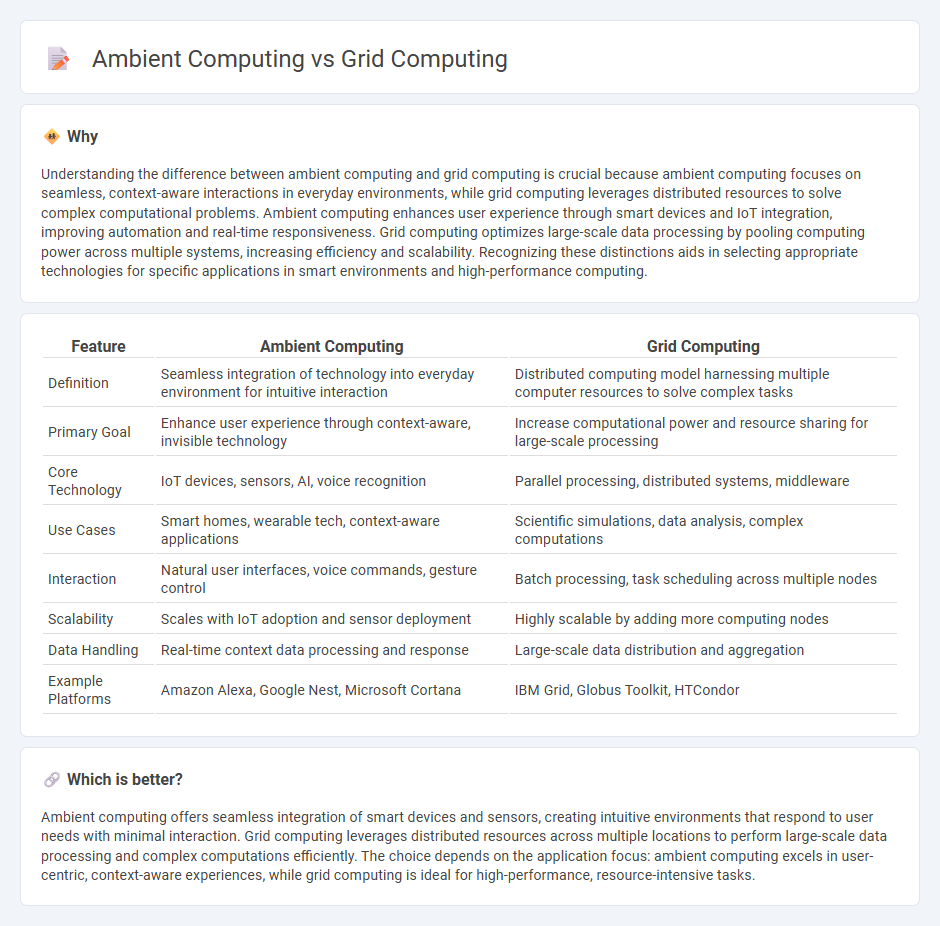
Ambient computing integrates technology seamlessly into everyday environments, enabling intuitive interaction with smart devices through sensors, voice recognition, and context-aware systems. Grid computing, by contrast, harnesses a network of distributed computers to perform complex tasks by sharing processing power, storage, and resources for large-scale data analysis and scientific simulations. Explore the evolving dynamics between ambient and grid computing to understand their distinct roles in shaping future technology landscapes.
Why it is important
Understanding the difference between ambient computing and grid computing is crucial because ambient computing focuses on seamless, context-aware interactions in everyday environments, while grid computing leverages distributed resources to solve complex computational problems. Ambient computing enhances user experience through smart devices and IoT integration, improving automation and real-time responsiveness. Grid computing optimizes large-scale data processing by pooling computing power across multiple systems, increasing efficiency and scalability. Recognizing these distinctions aids in selecting appropriate technologies for specific applications in smart environments and high-performance computing.
Comparison Table
| Feature | Ambient Computing | Grid Computing |
|---|---|---|
| Definition | Seamless integration of technology into everyday environment for intuitive interaction | Distributed computing model harnessing multiple computer resources to solve complex tasks |
| Primary Goal | Enhance user experience through context-aware, invisible technology | Increase computational power and resource sharing for large-scale processing |
| Core Technology | IoT devices, sensors, AI, voice recognition | Parallel processing, distributed systems, middleware |
| Use Cases | Smart homes, wearable tech, context-aware applications | Scientific simulations, data analysis, complex computations |
| Interaction | Natural user interfaces, voice commands, gesture control | Batch processing, task scheduling across multiple nodes |
| Scalability | Scales with IoT adoption and sensor deployment | Highly scalable by adding more computing nodes |
| Data Handling | Real-time context data processing and response | Large-scale data distribution and aggregation |
| Example Platforms | Amazon Alexa, Google Nest, Microsoft Cortana | IBM Grid, Globus Toolkit, HTCondor |
Which is better?
Ambient computing offers seamless integration of smart devices and sensors, creating intuitive environments that respond to user needs with minimal interaction. Grid computing leverages distributed resources across multiple locations to perform large-scale data processing and complex computations efficiently. The choice depends on the application focus: ambient computing excels in user-centric, context-aware experiences, while grid computing is ideal for high-performance, resource-intensive tasks.
Connection
Ambient computing integrates seamlessly with grid computing by leveraging distributed resources to provide context-aware, real-time processing across multiple devices and environments. Grid computing offers the scalable infrastructure and computational power required for ambient systems to analyze vast data streams and deliver personalized user experiences efficiently. This synergy enables enhanced interoperability, resource sharing, and pervasive connectivity fundamental to smart environments and IoT applications.
Key Terms
Distributed Resources (Grid Computing)
Grid computing leverages distributed resources by pooling geographically dispersed computing power, storage, and data to perform large-scale tasks efficiently, often used in scientific research and complex simulations. This approach enables resource sharing across diverse administrative domains while ensuring high levels of computation and data throughput. Explore how grid computing optimizes distributed resources for advanced problem-solving and collaborative projects.
Context-awareness (Ambient Computing)
Ambient computing leverages advanced sensors and AI to enable context-awareness, allowing systems to seamlessly adapt to environmental changes and user behaviors in real-time. In contrast, grid computing primarily focuses on distributed resource sharing and task parallelization without inherently understanding or reacting to contextual factors. Explore how ambient computing's context-aware capabilities revolutionize user interaction and system responsiveness.
Middleware (Both)
Grid computing middleware facilitates resource sharing, coordination, and management across distributed computing environments, enabling seamless integration of heterogeneous systems for complex computational tasks. Ambient computing middleware emphasizes context-awareness, seamless interaction, and intelligence across pervasive devices to create adaptive and user-centric environments. Explore more insights on how middleware drives innovation in both grid and ambient computing paradigms.
Source and External Links
What Is Grid Computing? (Definition, Applications) - Grid computing is an infrastructure that connects geographically dispersed computers via a network to work together on common tasks, coordinated by a control node and middleware software that assigns tasks and aggregates results.
What is Grid Computing? - Grid computing involves a user node requesting resources across a network of provider nodes coordinated by middleware on a control node, enabling tasks like simulations and data storage across computational, scavenging, and data grids.
What is Grid Computing - Definition - It is a networked group of computers acting as a virtual supercomputer to perform large-scale tasks, often using idle machines and enabling efficient resource use without time dependencies, with considerations on security and redundancy.
 dowidth.com
dowidth.com